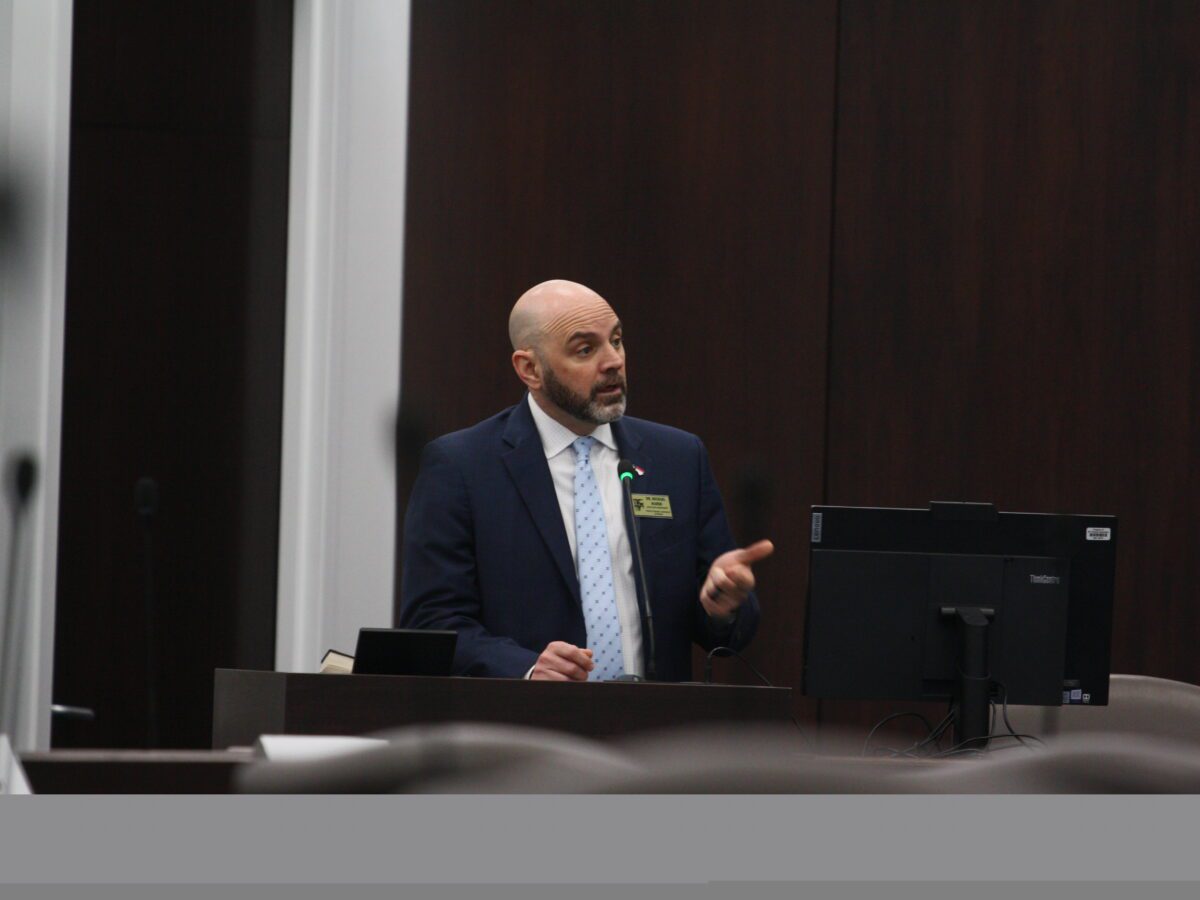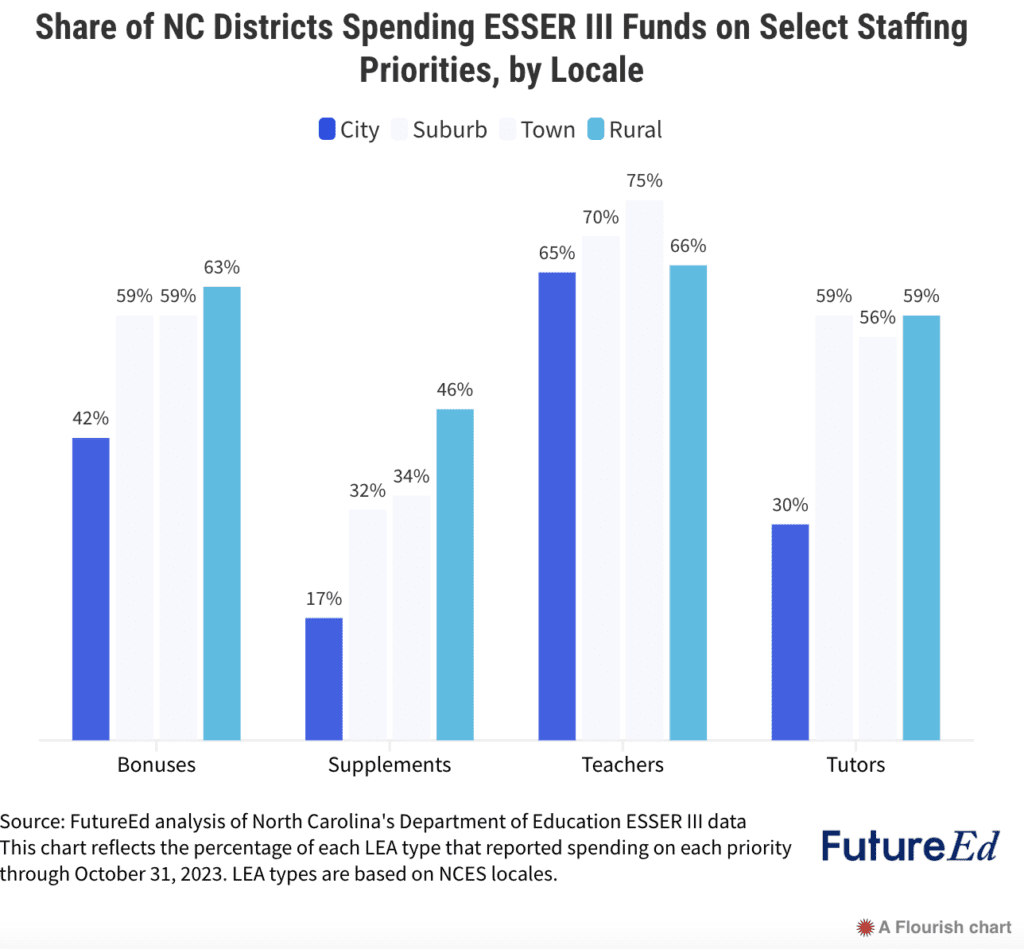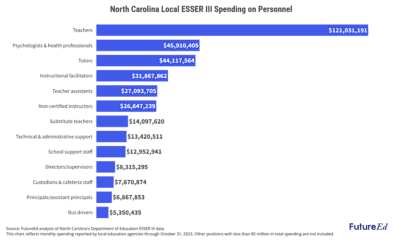
|
|
During the height of the pandemic, states received nearly $122 billion in Elementary and Secondary Schools Emergency Relief (ESSER III) funds to address student academic, social, emotional, and mental health needs. North Carolina received $3.6 billion, on top of previous federal Covid relief dollars.
Now, districts must spend those funds by Sept. 30 — a deadline coming to be known as “the funding cliff.” On Monday, officials from the Department of Public Instruction (DPI) presented a “ESSER Funding Cliff Toolkit” to state lawmakers at a House education reform meeting.
The toolkit seeks to help districts with “data-driven financial decision making for post-ESSER spending,” per DPI’s presentation.
“The toolkit is built to really support leaders in public schools as they think about the end of ESSER funding,” said Dr. Michael Maher, DPI’s deputy state superintendent. “The idea is we want districts to be able to have the toolkit to have really good conversations about how they spent their money, and whether those funds were effective or not.”
States received three rounds of ESSER funding during the pandemic. The first round — roughly $13.2 billion — largely went toward personal protective equipment and devices for students to safely reopen schools. The second and third rounds — nearly $123 billion — were a little more flexible, but were intended to support academic and mental health at schools as they recovered from Covid.
DPI’s toolkit is specifically designed to help discussions between district leaders like the superintendent (or charter school leader), chief financial officer, and administrators with budgetary responsibilities. DPI presented the toolkit to superintendents across the state last month, Maher said, and is also hosting regional sessions in February.
The purpose of the ESSER Funding Cliff Toolkit is to provide PSU (Public School Unit) leaders with relevant information and data around ESSER expenditures and student outcomes as well as resources to understand which ESSER investments were most effective. The data sources, tools, and information in this toolkit alone cannot provide answers to all these questions. However, this toolkit is designed to support a data-driven approach to evaluating investments and budgeting post-ESSER funding beyond September 2024. By approaching this process early, PSU leaders will be able to fully understand what worked during ESSER and develop plans for sustaining or sunsetting various programs and initiatives.
DPI’s presentation, ESSER Funding Cliff Toolkit
Among other things, the toolkit includes data on each district’s overall expenditures, and how ESSER funding fit into the budget. The guide also includes a formula to determine the return on investment (ROI) of various investments and strategies. That formula includes a multiplier for “special populations hurt most by the pandemic,” Maher said.
Districts should not include any one-time expenditures in their ROI discussions, per the presentation. Interventions that might be discussed in this process include high-dosage tutoring, summer learning initiatives, and robotics programs.
“The expectation is that the district now really has to make a decision about whether or not to continue an intervention,” Maher said. “In essence, this is what we’re trying to do, is give them the best available data that we can to help them drive themselves to the right decision for their given school, for their given context.”
Here are a few strategies the presentation identified for continuing initiatives currently funded through federal relief funds:
- Apply for specific grant funding, from private or federal sources.
- Request an increase in local funding from county commissioners.
- Use an innovative approach of “braiding” or overlapping federal funds.
- Identify funding from within current budget.
You can view DPI’s full presentation here, and its full toolkit here. Check out DPI’s dashboard’s for ESSER spending by school district here.
More on remaining funds, cliff
In March 2021, State Superintendent Catherine Truitt created the Office of Learning Recovery and Acceleration to help find and make evidence-based decisions regarding recovery from lost instructional time during the start of the pandemic — with a large focus on how to spend ESSER funds well.
The state received roughly $6 billion total in federal Covid funds for K-12 education, Maher told lawmakers. Approximately $1.3 billion of North Carolina’s ESSER III funds remained to be allocated as of Oct. 31, according to a December report by The 74.
DPI’s toolkit includes a starting point for districts of last December through the end of this month. During this time, the presentation says, districts should convene a team to focus on evaluating ESSER spending. The toolkit presentation includes the following questions:
- What is the PSU’s risk for a dramatic fiscal cliff post-ESSER?
- What initiatives/programs/expenditures will different groups of stakeholders be most interested in sustaining post-ESSER?
- What are the PSU’s top 2-3 priorities and which expenditures most support those priorities?
Districts should obligate all their funds by April or May of 2024, Maher said. This is to ensure no funds get reverted back to the federal government after the September deadline.
An ERS report issued in March 2023 identified 15 states facing the most complex challenges with the cliff. North Carolina was one of them.
However, a recent FutureEd analysis found that North Carolina school districts — especially in rural regions — generally spent more of their ESSER funds on short-term staffing fixes than long-term personnel commitments. “This decision could potentially ease their fiscal pain when the funds run out,” the 74 report found.

On Monday, Rep. Brian Biggs, R-Randolph, asked Maher about how DPI is approaching planning for the replacement of technologies funded in the last few years through ESSER dollars.
“The technology, after two or three years, it’s just outdated. And that’s my big concern with the direction we’re headed in right now,” Biggs said. “If we can’t keep up with our students and our parents, they’re gonna find somewhere where they can keep up.”
Last month, DPI also gave a presentation to the education reform committee on student devices and home connectivity. That report showed that 114 of 115 school districts currently have one device per student. This allows students to take devices home with them to help with studying and homework.
However, 89 of 115 districts have reported they do not currently have sufficient resources “to sustain their refresh cycles for student devices beyond ESSER funding.” That’s more than 77% of districts.
Maher said that “a large chunk” of ESSER funds have gone toward HVAC systems, technology hardware and infrastructure, and access to broadband. He said DPI is still discussing how districts can “replenish technology as it becomes, in essence, out of date.”
Rep. John Torbett, R-Gaston, said good data will be key to good decisions moving forward.
“We’re going into post-Covid and those monies are running out,” Torbett said. “Hopefully, we have worked procedures out to help those agencies that used that money. For one time purposes should be okay, but there were some that have used the money for recurring expenses that we’ll be probably be hearing about in the days and weeks to come.”
If you have additional questions about DPI’s toolkit, email Rachel Wright-Junio, director of the Office of Learning Recovery & Acceleration, or Dr. Andrew Smith, the assistant state superintendent of DPI’s Office of Innovation.




